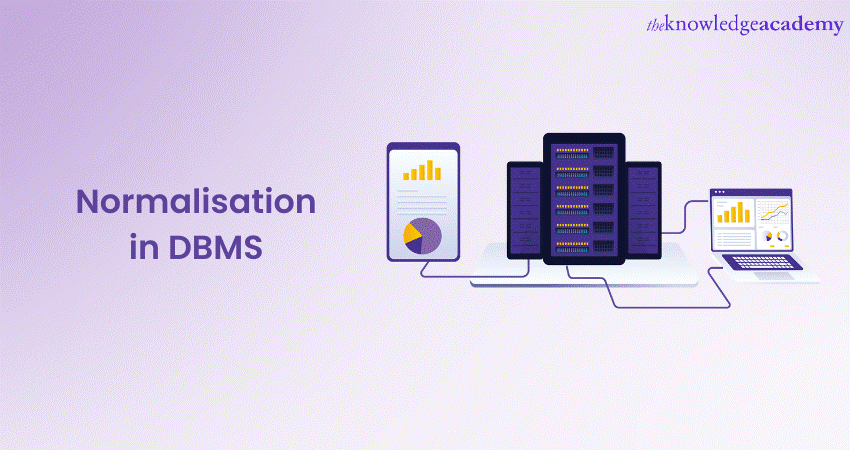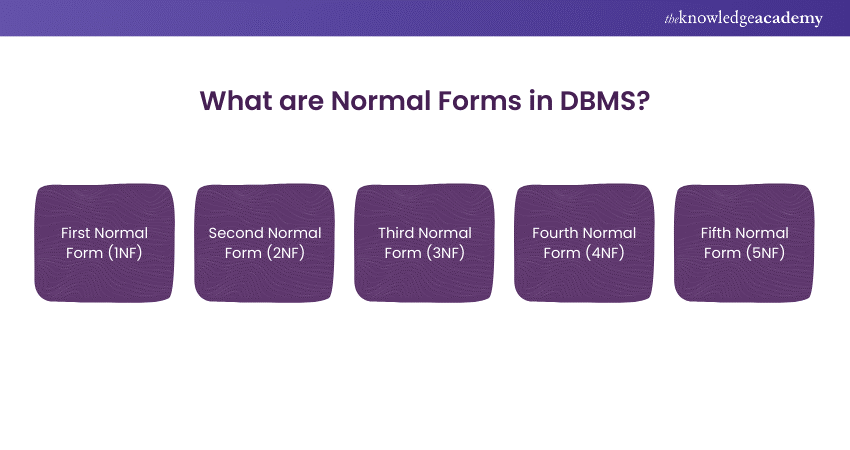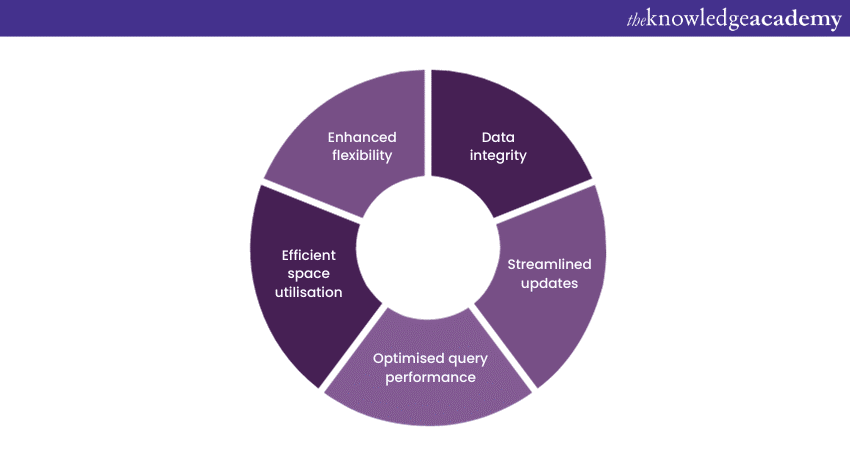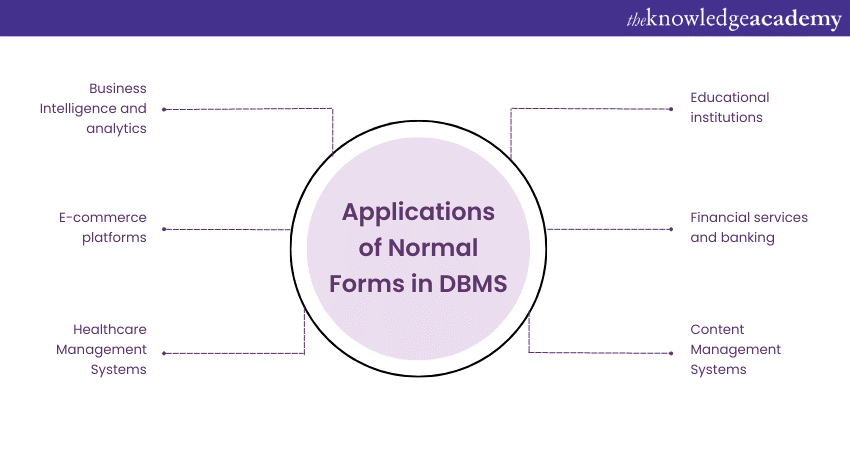We may not have the course you’re looking for. If you enquire or give us a call on 01344203999 and speak to our training experts, we may still be able to help with your training requirements.
We ensure quality, budget-alignment, and timely delivery by our expert instructors.

Data is considered to be a modern-day organisation’s most valuable resource. Modern-day, data-driven organisations aim to harness their data to get valuable insights and drive their operations in an informed manner. This makes Data Organisation paramount in importance, resulting in the growth in popularity of Database Management Systems (DBMS). One of its most relevant concepts is Normalisation, which we will expand on in this blog. So, without further ado, read on to know all about Normalisation in DBMS!
Table of Contents
1) What is Normalisation in DBMS?
2) What are Normal Forms in DBMS?
3) Advantages of Normal Forms in DBMS
4) Applications of Normal Forms in DBMS
5) Conclusion
What is Normalisation in DBMS?
Normalisation is a vital process in the operation of a Database Management System (DBMS), enhancing both the efficiency and integrity of data. At its core, Normalisation involves the methodical organisation of raw data into structured, logical, and interconnected formats. While exploring types of attributes in DBMS, it becomes evident how Normalisation helps eliminate redundancies and dependencies, ensuring data is stored in the most efficient way possible.
By adhering to specific rules and Normal Forms, Normalisation refines the Database, enhancing data accuracy, streamlining updates, and enabling efficient query execution. It transforms chaotic data into an organised masterpiece, ensuring that databases are not just repositories but strategic assets in the digital world, as outlined in the Database Management System Guide.
What are Normal Forms in DBMS?
Understanding the concept of Normal Forms is necessary to decipher the language of Normalisation and structured data. Normal Forms are systematic guidelines that define the levels of organisation within a Database. As Databases evolve from their raw, unorganised states to refined, optimised structures, they progress through these Normal Forms. The following are the different types of Normal Forms in DBMS:

First Normal Form (1NF)
At the heart of Normalisation lies the First Normal Form (1NF), the foundational step towards structured data. A table is in 1NF if it contains no repeating groups, and all its attributes hold atomic values – values that cannot be divided further. Imagine a table storing customer information; in 1NF, each piece of data is distinct, neatly fitting into its designated column, eliminating redundancy and ensuring clarity.
Second Normal Form (2NF)
Building upon 1NF, the Second Normal Form (2NF) refines the Database further. For a table to qualify as 2NF, it must be in 1NF and, additionally, all non-key attributes must be functionally dependent on the primary key. This means that every attribute should be relevant to the entire primary key, eliminating partial dependencies and streamlining data relationships.
Third Normal Form (3NF)
Progressing into the realms of 3NF, the focus shifts to eliminating transitive dependencies. A table is in Third Normal Form (3NF) when it is in 2NF, and no non-key attribute is dependent on another non-key attribute. In simpler terms, there should be no indirect relationships between attributes. This separation ensures that data integrity is upheld to the highest standard.
Fourth Normal Form (4NF)
Fourth Normal Form (4NF) tackles multi-valued dependencies, a more intricate aspect of Database design. When a table is in 3NF and there are no non-trivial multi-valued dependencies from candidate keys, it achieves 4NF. This level of Normalisation ensures that complex data relationships are handled with precision, avoiding data anomalies that might arise due to intricate dependencies.
Fifth Normal Form (5NF)
The pinnacle of Normalisation, Fifth Normal Form (5NF), deals with cases where certain relationships can't be represented by simpler Normal Forms. In 5NF, Databases are meticulously refined, ensuring that even the most complex data scenarios are addressed. This form is rarely reached but is crucial in specialised applications where absolute data accuracy is paramount.
Each Normal Form plays a vital role in creating an efficient, and reliable Database. By adhering to structured guidelines, Databases become resilient against anomalies, ensuring that data remains accurate, efficient, and easily manageable.
Preparing for a DBMS interview? Use our top DBMS Interview Questions and Answers to ensure you're ready!
Advantages of Normal Forms in DBMS
The following are the different advantages that Normal Forms provide to a DBMS.

1) Data integrity
Data integrity, the cornerstone of Normalisation, ensures that information is accurate and reliable. By eliminating redundancies and dependencies, Normalisation structures data with precision. This organisation guarantees the authenticity of stored data, fostering trust in decision-making processes.
In an era where data accuracy is paramount, businesses benefit immensely from this foundation of trust, ensuring that every piece of information, be it customer details or financial records, is steadfast and dependable, guiding strategic actions and bolstering organisational credibility.
2) Streamlined updates
Normalised Databases offer an advantage by facilitating seamless updates. In a world where information is constantly in flux, the ability to incorporate changes swiftly is crucial. Normalisation’s structured approach ensures that updates are localised and contained within specific data pockets, eliminating the risk of cascading alterations.
This agility empowers businesses to respond promptly to evolving market demands, regulatory changes, or internal restructuring. Timely updates maintain the relevance and accuracy of data, enabling organisations to remain agile, competitive, and compliant, all the while ensuring operational efficiency and strategic alignment.
3) Optimised query performance
Efficient query performance is the hallmark of a Normalised Database. Organised into structured, optimised formats, Normalised data allows for swift, precise retrieval. Queries execute seamlessly, delivering results promptly even for complex data requests. This speed enhances user experience significantly, enabling real-time analytics and decision-making.
Whether in customer service applications or data-intensive research environments, the ability to obtain rapid responses to queries is indispensable. Normalisation’s impact on query performance not only improves operational efficiency but also empowers businesses to glean insights swiftly, empowering strategic decisions and enhancing overall productivity.
Build Reliable Databases! See How Domain Constraints in DBMS Improve Data Quality.
4) Efficient space utilisation
Space optimisation is a paramount advantage of a Normalised Database. Redundancies, a common space hog, are eradicated through proper structuring. Each byte is maximised, reducing storage costs and ensuring scalable growth without exponential storage demands. In an era where data volumes expand exponentially, the efficient utilisation of space is invaluable.
Normalisation's space-saving techniques enable businesses to store vast amounts of data without incurring exorbitant infrastructure costs. This economic efficiency not only improves cost-effectiveness but also ensures that valuable resources are allocated judiciously, allowing organisations to invest in innovation and growth, rather than just infrastructure maintenance.
5) Enhanced flexibility
The adaptability of Normalised Databases is a game-changer. In an era where business landscapes transform rapidly, this flexibility is invaluable. Fields can be added, modified, or removed with ease, aligning the Database precisely with evolving business needs. Whether accommodating new product lines, regulatory changes, or customer data requirements, Normalisation ensures that the Database structure remains agile.
This adaptability translates into operational resilience, enabling businesses to innovate and pivot swiftly, ensuring that they stay ahead of the curve. Normalisation’s ability to accommodate change seamlessly is a strategic asset, ensuring that organisations remain not just reactive, but proactive, in their market strategies and operations.
6) Minimised redundancy
Normalisation's structured approach minimises redundancy, ensuring each piece of data is stored once and referenced appropriately. Redundancies not only consume valuable storage space but also jeopardise data accuracy. By eliminating duplicate information, Normalisation not only optimises storage but also enhances data integrity.
A well-organised Database, free from redundancy, ensures that each data point is consistent, reliable, and coherent. In an era where precision and efficiency are paramount, minimised redundancy not only conserves resources but also fosters trust in the information stored, enabling businesses to operate with confidence, making decisions based on accurate, singular data sources.
7) Simplified maintenance
Normalised Databases offer the gift of simplified maintenance, streamlining the complex task of managing vast datasets. With data organised into clear, defined relationships, maintenance tasks become targeted and efficient. Updates, troubleshooting, and error resolution are localised, enabling Database administrators to pinpoint issues swiftly. This precision not only reduces downtime but also enhances the overall reliability of the system.
Simplified maintenance ensures that Databases remain agile and responsive, capable of adapting to changing requirements without disruptions. In a world where data is dynamic, a Database that is easy to maintain ensures continuous, smooth operations, enabling businesses to focus on strategic endeavours rather than routine maintenance tasks.
Master MongoDB for App and Web Development – register for our MongoDB Developer Training now!
Applications of Normal Forms in DBMS
The following are the many applications of Normal Forms in DBMS.

1) Business Intelligence and analytics
In the realm of Business Intelligence, Normalised Databases serve as the bedrock for insightful decision-making. By organising vast datasets into efficient structures, businesses can extract meaningful patterns and trends. Normalised data ensures consistency, allowing analytical tools to provide accurate insights.
Whether identifying market trends, forecasting demands, or understanding customer behaviour, Normalised Databases enhance the precision of analytics. Through structured information, businesses gain a competitive edge, enabling them to make strategic choices rooted in data-driven wisdom, guiding their ventures towards success.
2) E-commerce platforms
E-commerce platforms, bustling hubs of online commerce, rely on Normalised Databases for seamless operations. Product catalogues, customer profiles, and transaction records are meticulously organised, ensuring swift access and accurate processing. Normalisation streamlines inventory management, enabling efficient tracking of stock levels and customer preferences.
This precision enhances customer experiences, allowing tailored product recommendations and efficient order processing. From online marketplaces to digital storefronts, a Normalised Database is the backbone that ensures that e-commerce platforms deliver seamless, personalised services, fostering customer satisfaction and loyalty.
3) Healthcare Management Systems
In the critical domain of healthcare, Normalised Databases safeguard patient information with precision and confidentiality. Electronic Health Records (EHR), treatment plans, and medical histories are structured in compliance with Normal Forms. This ensures accurate patient care, facilitates streamlined communication among medical professionals, and supports evidence-based decision-making.
Normalisation guarantees data integrity, enabling healthcare providers to access comprehensive, reliable information swiftly. By maintaining the sanctity of patient data, Normalised Databases elevate healthcare services, fostering trust between patients and medical professionals while ensuring the delivery of high-quality, personalised healthcare.
4) Content Management Systems
Content Management Systems (CMS) are epicentres of digital content, and Normalised Databases are fundamental in their efficiency. Structured data in CMS ensures seamless management of articles, multimedia, user data, and metadata. By adhering to Normalisation principles, CMS platforms facilitate efficient content creation, categorisation, and retrieval.
Editorial workflows, user interactions, and content personalisation are all optimised through organised Databases. Normalised CMS empower content creators and marketers, enabling them to manage digital assets effectively, enhance user experiences, and maintain the coherence of digital content across diverse platforms.
5) Financial services and banking
The financial sector, reliant on accuracy and security, benefits profoundly from Normalised Databases. Customer information, transactions, and financial records are organised, ensuring data integrity and regulatory compliance. Normalisation optimises query performance, enabling swift processing of transactions, loan approvals, and risk assessments.
By adhering to Normal Forms, financial institutions bolster customer trust, streamline operations, and ensure the accuracy of financial data. Structured Databases empower banking professionals to make informed decisions, manage risks, and deliver superior financial services, creating a robust and reliable financial ecosystem.
6) Educational institutions
Educational institutions, reservoirs of student information, leverage Normalised Databases for streamlined operations. Student enrolment data, academic records, schedules, and administrative details are meticulously structured. Normalisation ensures efficient management of student profiles, class schedules, and examination results. Through well-organised Databases, educational institutions simplify administrative tasks, enabling seamless communication between educators, administrators, and students.
Structured information enhances educational experiences, ensuring accurate academic records and fostering a conducive learning environment. Normalised Databases empower educational institutions to focus on nurturing young minds, providing quality education while maintaining the integrity of institutional data.
Unlock your potential in App and Web Development with our expert App & Web Development Training Courses – sign up now!
Conclusion
To sum it up, Normalisation in DBMS is indispensable for maintaining data accuracy, efficiency, and integrity in modern information systems. By organising data into different normal forms, Databases become more streamlined, robust, and adaptable. From business applications to healthcare systems, Normalised Databases form the backbone of various essential services, ensuring seamless operations and reliable Data Management.
Master your Cloud Database Skills today by signing up for our Amazon DocumentDB with MongoDB Course!
Frequently Asked Questions
What are the Other Resources and Offers Provided by The Knowledge Academy?

The Knowledge Academy takes global learning to new heights, offering over 3,000 online courses across 490+ locations in 190+ countries. This expansive reach ensures accessibility and convenience for learners worldwide.
Alongside our diverse Online Course Catalogue, encompassing 19 major categories, we go the extra mile by providing a plethora of free educational Online Resources like News updates, Blogs, videos, webinars, and interview questions. Tailoring learning experiences further, professionals can maximise value with customisable Course Bundles of TKA.
Upcoming Programming & DevOps Resources Batches & Dates
Date
 Amazon DocumentDB with MongoDB
Amazon DocumentDB with MongoDB
Fri 23rd May 2025
Fri 25th Jul 2025
Fri 26th Sep 2025
Fri 28th Nov 2025






 Top Rated Course
Top Rated Course



 If you wish to make any changes to your course, please
If you wish to make any changes to your course, please


